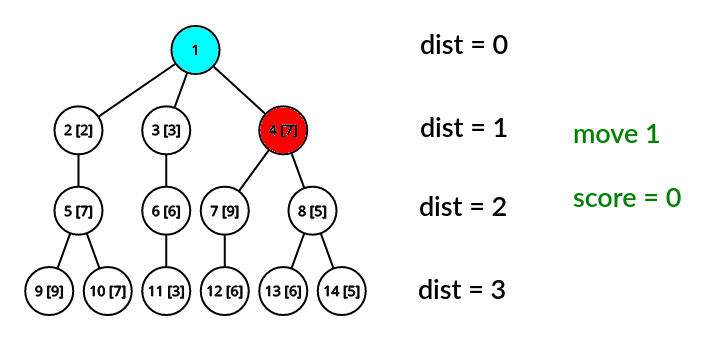CF1485E.Move and Swap
普及/提高-
通过率:0%
AC君温馨提醒
该题目为【codeforces】题库的题目,您提交的代码将被提交至codeforces进行远程评测,并由ACGO抓取测评结果后进行展示。由于远程测评的测评机由其他平台提供,我们无法保证该服务的稳定性,若提交后无反应,请等待一段时间后再进行重试。
题目描述
You are given n−1 integers a2,…,an and a tree with n vertices rooted at vertex 1 . The leaves are all at the same distance d from the root.
Recall that a tree is a connected undirected graph without cycles. The distance between two vertices is the number of edges on the simple path between them. All non-root vertices with degree 1 are leaves. If vertices s and f are connected by an edge and the distance of f from the root is greater than the distance of s from the root, then f is called a child of s .
Initially, there are a red coin and a blue coin on the vertex 1 . Let r be the vertex where the red coin is and let b be the vertex where the blue coin is. You should make d moves. A move consists of three steps:
- Move the red coin to any child of r .
- Move the blue coin to any vertex b′ such that dist(1,b′)=dist(1,b)+1 . Here dist(x,y) indicates the length of the simple path between x and y . Note that b and b′ are not necessarily connected by an edge.
- You can optionally swap the two coins (or skip this step).
Note that r and b can be equal at any time, and there is no number written on the root.
After each move, you gain ∣ar−ab∣ points. What's the maximum number of points you can gain after d moves?
输入格式
The first line contains a single integer t ( 1≤t≤104 ) — the number of test cases.
The first line of each test case contains a single integer n ( 2≤n≤2⋅105 ) — the number of vertices in the tree.
The second line of each test case contains n−1 integers v2,v3,…,vn ( 1≤vi≤n , vi=i ) — the i -th of them indicates that there is an edge between vertices i and vi . It is guaranteed, that these edges form a tree.
The third line of each test case contains n−1 integers a2,…,an ( 1≤ai≤109 ) — the numbers written on the vertices.
It is guaranteed that the sum of n for all test cases does not exceed 2⋅105 .
输出格式
For each test case, print a single integer: the maximum number of points you can gain after d moves.
输入输出样例
输入#1
4 14 1 1 1 2 3 4 4 5 5 6 7 8 8 2 3 7 7 6 9 5 9 7 3 6 6 5 6 1 2 2 3 4 32 78 69 5 41 15 1 15 1 10 4 9 11 2 4 1 8 6 10 11 62 13 12 43 39 65 42 86 25 38 19 19 43 62 15 11 2 7 6 9 8 10 1 1 1 5 3 15 2 50 19 30 35 9 45 13 24 8 44 16 26 10 40
输出#1
14 45 163 123
说明/提示
In the first test case, an optimal solution is to:
- move 1 : r=4 , b=2 ; no swap;
- move 2 : r=7 , b=6 ; swap (after it r=6 , b=7 );
- move 3 : r=11 , b=9 ; no swap.
The total number of points is ∣7−2∣+∣6−9∣+∣3−9∣=14 .
 In the second test case, an optimal solution is to:
In the second test case, an optimal solution is to:
- move 1 : r=2 , b=2 ; no swap;
- move 2 : r=3 , b=4 ; no swap;
- move 3 : r=5 , b=6 ; no swap.
The total number of points is ∣32−32∣+∣78−69∣+∣5−41∣=45 .